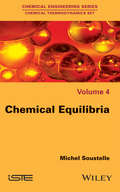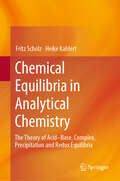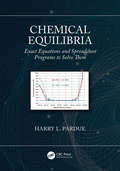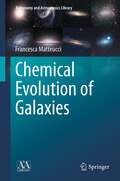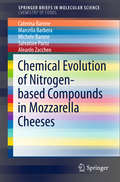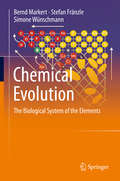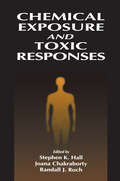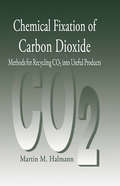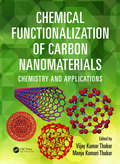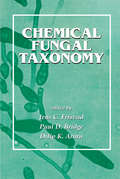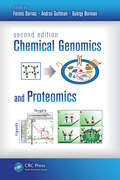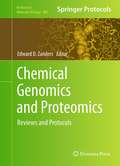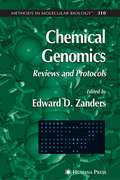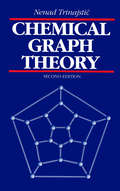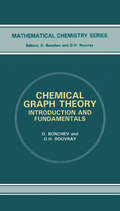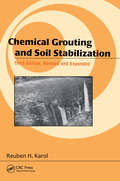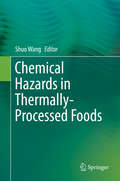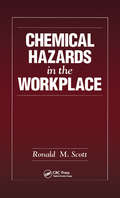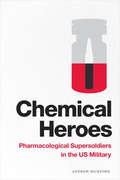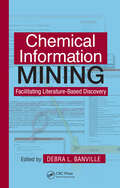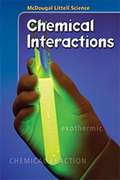- Table View
- List View
Chemical Equilibria
by Michel SoustelleThe book offers advanced students, in 7 volumes, successively characterization tools phases, the study of all types of phase, liquid, gas and solid, pure or multi-component, process engineering, chemical and electrochemical equilibria, the properties of surfaces and phases of small sizes. Macroscopic and microscopic models are in turn covered with a constant correlation between the two scales. Particular attention was given to the rigor of mathematical developments. Besides some very specialized books, the vast majority of existing works are intended for beginners and therefore limited in scope. There is no obvious connection between the two categories of books, general books does not go far enough in generalizing concepts to enable easy reading of advanced literature. The proposed project aims to give readers the ability to read highly specialized publications based on a more general presentation of the different fields of chemical thermodynamics. Consistency is ensured between the basic concepts and applications. So we find, in the same work, the tools, their use and comparison, for a more general macroscopic description and a microscopic description of a phase.
Chemical Equilibria in Analytical Chemistry: The Theory of Acid–Base, Complex, Precipitation and Redox Equilibria
by Heike Kahlert Fritz ScholzThis book provides a modern and easy-to-understand introduction to the chemical equilibria in solutions. It focuses on aqueous solutions, but also addresses non-aqueous solutions, covering acid–base, complex, precipitation and redox equilibria. The theory behind these and the resulting knowledge for experimental work build the foundations of analytical chemistry. They are also of essential importance for all solution reactions in environmental chemistry, biochemistry and geochemistry as well as pharmaceutics and medicine. Each chapter and section highlights the main aspects, providing examples in separate boxes. Questions and answers are included to facilitate understanding, while the numerous literature references allow students to easily expand their studies.
Chemical Equilibria: Exact Equations and Spreadsheet Programs to Solve Them
by Harry L. PardueConcepts, procedures and programs described in this book make it possible for readers to solve both simple and complex equilibria problems quickly and easily and to visualize results in both numerical and graphical forms. They allow the user to calculate concentrations of reactants and products for both simple and complicated situations. The user can spend less time doing calculations and more time thinking about what the results mean in terms of a larger problem in which she or he may be interested.
Chemical Evolution of Galaxies (Astronomy and Astrophysics Library #253)
by Francesca MatteucciThe term "chemical evolution of galaxies" refers to the evolution of abundances of chemical species in galaxies, which is due to nuclear processes occurring in stars and to gas flows into and out of galaxies. This book deals with the chemical evolution of galaxies of all morphological types (ellipticals, spirals and irregulars) and stresses the importance of the star formation histories in determining the properties of stellar populations in different galaxies. The topic is approached in a didactical and logical manner via galaxy evolution models which are compared with observational results obtained in the last two decades: The reader is given an introduction to the concept of chemical abundances and learns about the main stellar populations in our Galaxy as well as about the classification of galaxy types and their main observables. In the core of the book, the construction and solution of chemical evolution models are discussed in detail, followed by descriptions and interpretations of observations of the chemical evolution of the Milky Way, spheroidal galaxies, irregular galaxies and of cosmic chemical evolution. The aim of this book is to provide an introduction to students as well as to amend our present ideas in research; the book also summarizes the efforts made by authors in the past several years in order to further future research in the field.
Chemical Evolution of Nitrogen-based Compounds in Mozzarella Cheeses (SpringerBriefs in Molecular Science)
by Salvatore Parisi Caterina Barone Aleardo Zaccheo Marcella Barbera Michele BaroneThis Brief evaluates the consequences of protein modifications in cheeses, with special emphasis on mozzarella cheeses. It explains the influence of biogenic amines on food quality and safety. As certain biogenic amines display a toxic potential to humans, considerable research has been undertaken in recent years to evaluate their presence in fermented foods, such as cheeses. This Brief summarizes how the presence of amines is influenced by different factors such as cheese variety, seasoning and microflora. The authors compare typical profiles of different products, e.g. ripe vs. unripe cheeses, focusing also on the different types of mozzarella cheeses. The Brief also introduces several analytical methods and simulation techniques, which are being used to evaluate the evolutive profiles of different selected molecules, protein aggregation, or proteolysis.
Chemical Evolution: The Biological System of the Elements
by Stefan Fränzle Bernd Markert Simone WünschmannThis book is written for researchers and students interested in the function and role of chemical elements in biological or environmental systems. Experts have long known that the Periodic System of Elements (PSE) provides only an inadequate chemical description of elements of biological, environmental or medicinal importance. This book explores the notion of a Biological System of the Elements (BSE) established on accurate and precise multi-element data, including evolutionary aspects, representative sampling procedures, inter-element relationships, the physiological function of elements and uptake mechanisms. The book further explores the concept Stoichiometric Network Analysis (SNA) to analyze the biological roles of chemical species. Also discussed is the idea of ecotoxicological identity cards which give a first-hand description of properties relevant for biological and toxicological features of a certain chemical element and its geo biochemically plausible speciation form. The focus of this book goes beyond both classical bioinorganic chemistry and toxicology.
Chemical Exposure and Toxic Responses
by Stephen K. HallProviding material for practitioners and students alike, Chemical Exposure and Toxic Responses is a clear and straightforward presentation of industrial toxicology.Exposure to toxic chemicals is of major concern to health professionals. In recent years, the scope and importance of hazardous materials toxicology has expanded and now impacts financial institutions, government, private corporations, and many other organizations as well. Chemical Exposure and Toxic Responses presents the myriad health implications of hazardous chemicals in a single source. This book is organized so that readers can proceed from a general perspective on the problem of chemical exposure and toxic responses to an understanding of toxicology and a method of inquiry.Written for anyone who needs practical toxicological information, the book compactly and efficiently presents the scientific basis of toxicology as it applies to the workplace. It covers the diverse chemical hazards encountered in the work environment and provides a practical understanding of these hazards for those charged with protecting the health and well being of people at work.Chemical Exposure and Toxic Responses consists of three parts: Part I establishes the general principles of industrial toxicology; Part II addresses specific effects of toxic agents on specific physiological organs and systems; and Part III is devoted to the evaluation of hazards in the workplace.
Chemical Fixation of Carbon DioxideMethods for Recycling CO2 into Useful Products
by Martin M. HalmannChemical Fixation of Carbon Dioxide presents new concepts and results from research into the problems caused by increasing levels of carbon dioxide. The book discusses the limitations of natural plant photosynthesis as a sink for carbon dioxide and emphasizes chemical fixation as an important alternative. A number of significant topics are covered, including new coupling reactions for producing compounds such as carbamates, urethanes, and heterocyclic structures; new catalyst systems, particularly for methanation and methanol synthesis; the use of homogeneous solution photosensitizers and heterogeneous semiconductor photocatalysts to photoreduce carbon dioxide with visible light and sunlight; and electrochemical reduction. This book will be a useful reference for organic chemists working on environmental problems, chemical engineers, environmental chemists, professionals at research facilities, and students.
Chemical Functionalization of Carbon Nanomaterials: Chemistry and Applications
by Vijay Kumar Thakur Manju Kumari ThakurCarbon-based nanomaterials are rapidly emerging as one of the most fascinating materials in the twenty-first century. Chemical Functionalization of Carbon Nanomaterials: Chemistry and Applications provides a thorough examination of carbon nanomaterials, including their variants and how they can be chemically functionalized. It also gives a comprehe
Chemical Fungal Taxonomy
by Jens C. FrisvadOffers comprehensive coverage of the latest developments in both biochemical and physiological approaches to fungal systematics. Incorporates recent advances in molecular biology into systematics methods that can revolutionize taxonomic schemes.
Chemical Genomics
by Haian FuAdvances in chemistry, biology, and genomics coupled with laboratory automation and computational technologies have led to the rapid emergence of the multidisciplinary field of chemical genomics. This edited text with contributions from experts in the field discusses evolving concepts, essential techniques, and a wide range of applications to help further the study of chemical genomics. The beginning chapters provide an overview of the basic principles of chemical biology and chemical genomics. This is followed by a technical section that describes the sources of small molecule chemicals, the basics of high-throughput screening technologies, various bioassays for biochemical-, cellular-, and organism-based screens, and computational approaches. The final chapters connect the chemical genomics field with personalized medicine and the druggable genome for future discovery of new therapeutics. In selected chapters, a resource section is included for further information. This book provides an introduction to the principles of chemical genomics, serves as a resource for the associated technologies, and gives readers general concepts, useful vocabulary, practical techniques, and broad, forward-thinking perspectives. This book will be valuable to researchers, professionals, and students in many fields besides chemical genomics, including biology, biomedicine, chemistry, and drug discovery.
Chemical Genomics and Proteomics
by András Guttman Ferenc Darvas György DormánSince the publication of the pioneering first edition of Chemical Genomics and Proteomics more than seven years ago, the area of chemical genomics has rapidly expanded and diversified to numerous novel methods and subdisciplines, such as chemical glycomics and lipidomics. This second edition has been updated to uniquely reflect this interdisciplinary feature as well as the remarkable developments that have occurred. The new edition also covers innovative applications from cell biology to drug discovery to, more recently, clinical diagnostics and medical practice.
Chemical Genomics and Proteomics: Reviews and Protocols (Methods in Molecular Biology #800)
by Edward D. ZandersChemical genomics technology has been steadily improving, delivering new biological probes and drugs, and the explicit use of the term 'chemical proteomics' has increased with it, as proteins have always been at the heart of this technology. In Chemical Genomics and Proteomics: Reviews and Protocols, experts in the field present updated reviews of the chemistry of small molecules and their interaction with protein targets as well as detailed protocols that cover different types of ligands, carbohydrates, and lipids. For example, the generation of their protein targets and methods for measuring their interactions is covered. Written in the highly successful Methods in Molecular BiologyTM series format, methodology chapters include introductions to their respective topics, lists of the necessary materials and reagents, step-by-step, readily reproducible laboratory protocols, and tips on troubleshooting and avoiding known pitfalls. Thorough and up to date, Chemical Genomics and Proteomics: Reviews and Protocols aims to provide inspiration to those who wish to use chemical genomics and proteomics in their work and develop this young field into full maturity through the incorporation of the new biological and chemical technologies beginning to emerge here.
Chemical Genomics: Reviews and Protocols (Methods in Molecular Biology #310)
by Edward D. ZandersAn up-to-date introduction for the uninitiated into the various "flavors" of chemical genomics with a series of readily reproducible techniques for applications in organic chemistry, protein chemistry, and computer science, emphasizing the high-throughput approaches that are the essence of chemical genomics. The techniques range from the classic design of small molecules as affinity ligands for specific protein families, to in silico docking for computational approaches to protein-small molecule interactions, to producing highly diverse collections of proteins, carbohydrates, and small molecules for use in arrays containing large numbers of these molecules. There are also methods for the production of proteins and carbohydrates using different expression systems, for analyzing proteins using mass spectrometry, and for arraying proteins and carbohydrates on solid supports. The protocols follow the successful Methods in Molecular BiologyTM series format, each offering step-by-step laboratory instructions, an introduction outlining the principles behind the technique, lists of the necessary equipment and reagents, and tips on troubleshooting and avoiding known pitfalls.
Chemical Graph Theory
by Nenad TrinajsticNew Edition! Completely Revised and UpdatedChemical Graph Theory, 2nd Edition is a completely revised and updated edition of a highly regarded book that has been widely used since its publication in 1983. This unique book offers a basic introduction to the handling of molecular graphs - mathematical diagrams representing molecular structures. Using mathematics well within the vocabulary of most chemists, this volume elucidates the structural aspects of chemical graph theory: (1) the relationship between chemical and graph-theoretical terminology, elements of graph theory, and graph-theoretical matrices; (2) the topological aspects of the Hückel theory, resonance theory, and theories of aromaticity; and (3) the applications of chemical graph theory to structure-property and structure-activity relationships and to isomer enumeration. An extensive bibliography covering the most relevant advances in theory and applications is one of the book's most valuable features. This volume is intended to introduce the entire chemistry community to the applications of graph theory and will be of particular interest to theoretical organic and inorganic chemists, physical scientists, computational chemists, and those already involved in mathematical chemistry.
Chemical Graph Theory: Introduction and Fundamentals (Mathematical Chemistry Ser.)
by D BonchevThis volume presents the fundamentals of graph theory and then goes on to discuss specific chemical applications. Chapter 1 provides a historical setting for the current upsurge of interest in chemical graph theory. Chapter 2 gives a full background of the basic ideas and mathematical formalism of graph theory and includes such chemically relevant notions as connectedness, graph matrix representations, metric properties, symmetry and operations on graphs. This is followed by a discussion on chemical nomenclature and the trends in its rationalization by using graph theory, which has important implications for the storage and retrieval of chemical information. This volume also contains a detailed discussion of the relevance of graph-theoretical polynomials; it describes methodologies for the enumeration of isomers, incorporating the classical Polya method, as well as more recent approaches.
Chemical Grouting And Soil Stabilization, Revised And Expanded
by Reuben H. KarolFollowing shifting trends from remedial to preventive uses of grouting practices, this third edition covers all aspects of chemical grouting methods and applications. This reference highlights new ground improvement techniques as well as recent innovations in soil modification and stabilization procedures. It considers commercial alternatives to ground improvement, their relative advantages and disadvantages, and the engineering applications to which these methods are suited. Revised and expanded, this new edition assesses the role of new grouting techniques in the containment of hazardous waste and introduces numerous problems to illustrate concepts and facilitate instruction.
Chemical Hazards in Thermally-Processed Foods
by Shuo WangThis book summarizes the types, contents, analytical methods, formation mechanisms and control strategies for hazardous substances produced during the thermal processing of foods. In each chapter, hazardous substances such as dicarbonyl compounds, acrylamide, furan, heterocyclic amines, trans-fatty acids, and advanced glycation end products (AGEs) are covered and discussed in terms of analytical methods, formation mechanisms and mitigation strategies.The content chiefly focuses on how these hazardous substances are formed during thermal processing and what can be done to mitigate or eliminate them in food products (e.g. those prepared at higher temperatures by baking, frying or roasting).The major objective of this book is to provide a timely and informative guide for researchers and graduate students in the fields of food chemistry, food ingredients, food analysis, food safety, food processing, chemical toxicology, disease prevention and health promotion.
Chemical Hazards in the Workplace
by Ronald M. ScottThis book introduces you to Industrial Toxicology - and is especially valuable for the engineer, scientists, or manager with responsibility - but no previous education or experience in the subject. Very "User Friendly." Text at the upper undergraduate and graduate level.
Chemical Heroes: Pharmacological Supersoldiers In The Us Military
by Andrew BickfordIn Chemical Heroes Andrew Bickford analyzes the US military's attempts to design performance enhancement technologies and create pharmacological "supersoldiers" capable of withstanding extreme trauma. <P><P>Bickford traces the deep history of efforts to biologically fortify and extend the health and lethal power of soldiers from the Cold War era into the twenty-first century, from early adoptions of mandatory immunizations to bio-protective gear, to the development and spread of new performance enhancing drugs during the global War on Terrorism. In his examination of government efforts to alter soldiers' bodies through new technologies, Bickford invites us to contemplate what constitutes heroism when armor becomes built in, wired in, and even edited into the molecular being of an American soldier. Lurking in the background and dark recesses of all US military enhancement research, Bickford demonstrates, is the desire to preserve US military and imperial power.
Chemical Identification and its Quality Assurance
by Boris L. MilmanThis is the first book to show how to apply the principles of quality assurance to the identification of analytes (qualitative chemical analysis). After presenting the principles of identification and metrological basics, the author focuses on the reliability and the errors of chemical identification. This is then applied to practical examples such as EPA methods, EU, FDA, or WADA regulations. Two whole chapters are devoted to the analysis of unknowns and identification of samples such as foodstuffs or oil pollutions. Essential reading for researchers and professionals dealing with the identification of chemical compounds and the reliability of chemical analysis.
Chemical Information Mining: Facilitating Literature-Based Discovery
by Debra L. BanvilleThe First Book to Describe the Technical and Practical Elements of Chemical Text MiningExplores the development of chemical structure extraction capabilities and how to incorporate these technologies in daily research workFor scientific researchers, finding too much information on a subject, not finding enough information, or not being able&nb
Chemical Interactions
by Lawrence Hall of Science University of California at BerkeleyNIMAC-sourced textbook
